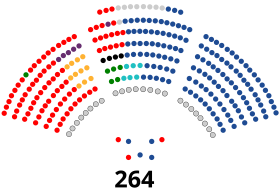
Back برلمان إسبانيا Arabic كورتيس خينيراليس ARZ Cortes Xenerales AST Парламент Іспаніі Byelorussian Parlemen Spanyol BJN Cortes Generales Breton Corts Generals Catalan Generální kortesy Czech Cortes Generales Danish Cortes Generales German
General Courts | |
|---|---|
| 15th Cortes Generales | |
| Type | |
| Type | |
| Houses | Senate Congress of Deputies |
| Leadership | |
| Structure | |
| Seats | 615 265 senators 350 deputies |
 | |
Senate political groups | Government (91)
Supported by (20) Opposition (153) |
 | |
Congress of Deputies political groups | Government (147)
Supported by (25) Opposition (178) |
| Elections | |
First Senate election | 15 June 1977 |
First Congress of Deputies election | January–September 1810 |
Last Senate election | 23 July 2023 |
Last Congress of Deputies election | 23 July 2023 |
| Meeting place | |
 | |
| Senate Palacio del Senado Plaza de la Marina Española Centro, Madrid | |
 | |
| Congress of Deputies Palacio de las Cortes Carrera de San Jerónimo Centro, Madrid | |
| Website | |
| cortesgenerales | |
The Cortes Generales (Spanish pronunciation: [ˈkoɾtes xeneˈɾales]; English: Spanish Parliament, lit. 'General Courts') are the bicameral legislative chambers of Spain, consisting of the Congress of Deputies (the lower house) and the Senate (the upper house).
The Congress of Deputies meets in the Palacio de las Cortes. The Senate meets in the Palacio del Senado. Both are in Madrid. The Cortes are elected through universal, free, equal, direct and secret suffrage,[1] with the exception of some senatorial seats, which are elected indirectly by the legislatures of the autonomous communities. The Cortes Generales are composed of 615 members: 350 Deputies and 265 Senators.
The members of the Cortes Generales serve four-year terms, and they are representatives of the Spanish people.[2] In both chambers, the seats are divided by constituencies that correspond with the fifty provinces of Spain, plus Ceuta and Melilla. However, each island or group of islands within the Canary and Balearic archipelagos forms a different constituency in the Senate.[3]
As a parliamentary system, the Cortes confirm and dismiss the Prime Minister of Spain and their government; specifically, the candidate for Prime Minister has to be invested by the Congress with a majority of affirmative votes. The Congress can also dismiss the Prime Minister through a vote of no confidence. The Cortes also hold the power to enact a constitutional reform.
The modern Cortes Generales were created by the 1978 Constitution of Spain, but the institution has a long history.
Cite error: There are <ref group=lower-alpha> tags or {{efn}} templates on this page, but the references will not show without a {{reflist|group=lower-alpha}} template or {{notelist}} template (see the help page).
- ^ Article 68.1 and 69.1 of the Constitution of Spain (1978)
- ^ Article 66 of the Constitution of Spain (1978)
- ^ Article 69.3 of the Constitution of Spain (1978)